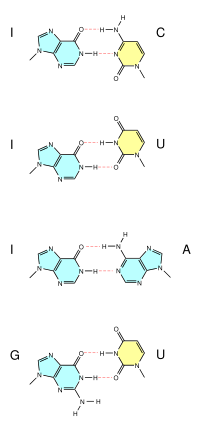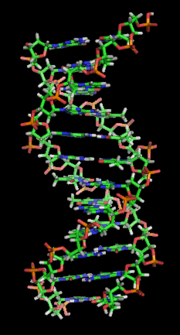A base pair (bp) is a fundamental unit of double-stranded nucleic acids consisting of two nucleobases bound to each other by hydrogen bonds. They form...
32 KB (3,677 words) - 10:59, 1 December 2023
wobble base pair is a pairing between two nucleotides in RNA molecules that does not follow Watson-Crick base pair rules. The four main wobble base pairs are...
13 KB (1,451 words) - 17:25, 20 April 2024
A Hoogsteen base pair is a variation of base-pairing in nucleic acids such as the A•T pair. In this manner, two nucleobases, one on each strand, can be...
8 KB (1,007 words) - 02:31, 29 June 2023
the new bond formed between the base and the proton is shown by an arrow that starts on an electron pair from the base and ends at the hydrogen ion (proton)...
13 KB (1,298 words) - 00:59, 6 February 2024
Non-canonical base pairs are planar hydrogen bonded pairs of nucleobases, having hydrogen bonding patterns which differ from the patterns observed in...
89 KB (11,720 words) - 14:39, 13 May 2024
Nucleic acid analogue (redirect from Base analog)
among other things, different base pairing and base stacking properties. Examples include universal bases, which can pair with all four canonical bases...
48 KB (5,268 words) - 21:53, 2 March 2024
Nucleic acid double helix (section Base pair geometry)
which base pair together. In B-DNA, the most common double helical structure found in nature, the double helix is right-handed with about 10–10.5 base pairs...
42 KB (5,017 words) - 07:43, 16 May 2024
Nucleobase (redirect from Nitrogenous base)
building blocks of nucleic acids. The ability of nucleobases to form base pairs and to stack one upon another leads directly to long-chain helical structures...
14 KB (1,376 words) - 14:57, 19 May 2024
Nucleotide (section Unnatural base pair (UBP))
oriented in opposite directions, which permits base pairing and complementarity between the base-pairs, all which is essential for replicating or transcribing...
32 KB (3,299 words) - 22:21, 6 May 2024
Chargaff's rules (redirect from Base-pairing rules)
percentage base pair equality: A% = T% and G% = C%. The rigorous validation of the rule constitutes the basis of Watson–Crick base pairs in the DNA double...
19 KB (2,014 words) - 22:06, 8 April 2024
Pairing-based cryptography is the use of a pairing between elements of two cryptographic groups to a third group with a mapping e : G 1 × G 2 → G T {\displaystyle...
7 KB (880 words) - 04:40, 19 February 2024
DNA (section Base pairing)
two separate polynucleotide strands are bound together, according to base pairing rules (A with T and C with G), with hydrogen bonds to make double-stranded...
166 KB (17,846 words) - 00:28, 23 May 2024
Ethernet over twisted-pair technologies use twisted-pair cables for the physical layer of an Ethernet computer network. They are a subset of all Ethernet...
33 KB (3,023 words) - 15:40, 25 April 2024
Point mutation (redirect from Base-pair substitution)
UV rays, X-rays or extreme heat, or chemical (molecules that misplace base pairs or disrupt the helical shape of DNA). Mutagens associated with cancers...
35 KB (4,359 words) - 07:19, 9 April 2024
Complementarity (molecular biology) (redirect from Complementary base)
as well as regulatory functions are based on base pair complementarity. In biotechnology, the principle of base pair complementarity allows the generation...
23 KB (2,586 words) - 20:09, 27 March 2024
Single-nucleotide polymorphism (redirect from Single base-pair polymorphism)
isoleucine)). nonsynonymous substitutions: missense – single change in the base results in change in amino acid of protein and its malfunction which leads...
57 KB (6,149 words) - 04:35, 17 May 2024
erythromycin base Base, one of the three terminals of a Bipolar junction transistor BASE experiment, an antiproton experiment at CERN Base pair, a pair of connected...
4 KB (578 words) - 13:21, 31 March 2024
informational polymer consisting of xeno nucleic acids (XNA), different base pairs, using non-canonical amino acids and an altered genetic code. So far cells...
39 KB (4,530 words) - 10:53, 4 April 2024
four standard nucleobases in both DNA and RNA molecules. Adenine forms a base pair with thymine in DNA and with uracil in RNA. adenosine (A) One of the four...
272 KB (24,805 words) - 05:52, 18 May 2024
Chromosome 21 (redirect from Chromosomes, human, pair 21)
one of the 23 pairs of chromosomes in humans. Chromosome 21 is both the smallest human autosome and chromosome, with 45 million base pairs (the building...
33 KB (2,969 words) - 20:55, 20 April 2024
Lewis acids and bases (redirect from Lewis base)
electron pair from a Lewis base to form a Lewis adduct. A Lewis base, then, is any species that has a filled orbital containing an electron pair which is...
22 KB (2,761 words) - 18:26, 10 March 2024
Nucleic acid secondary structure (section Base pairing)
hydrogen bonds are called a base pair (often abbreviated bp). In the canonical Watson-Crick base pairing, adenine (A) forms a base pair with thymine (T) and...
18 KB (2,194 words) - 07:26, 3 December 2023
An au pair (/oʊˈpɛər/; pl.: au pairs) is a person from a foreign country working for, and living as part of, a host family. Typically, au pairs take on...
62 KB (9,085 words) - 20:28, 28 April 2024
one million (1×106) bases in single-stranded molecules or one million base pairs in duplex molecules such as double-stranded DNA. meiosis A specialized...
253 KB (21,825 words) - 11:23, 19 May 2024
aspects of DNA. Because cytosine / guanine base-pairing is generally stronger than adenine / thymine base-pairing, the amount of cytosine and guanine in a...
24 KB (2,915 words) - 15:37, 7 March 2024
DNA synthesis (section Base pair synthesis)
backbone. DNA is a complementary, double stranded structure as specific base pairing (adenine and thymine, guanine and cytosine) occurs naturally when hydrogen...
14 KB (1,799 words) - 23:34, 8 April 2024
or base-pairs selected from the five primary, or canonical, nucleobases. RNA usually forms a chain of single bases, whereas DNA forms a chain of base pairs...
23 KB (2,743 words) - 08:13, 9 May 2024
Genome editing (redirect from Base editing)
their capacity to recognize and cut large DNA sequences (from 14 to 40 base pairs). The most widespread and best known meganucleases are the proteins in...
78 KB (9,341 words) - 20:34, 24 April 2024
partner strand. Genes are arranged linearly along long chains of DNA base-pair sequences. In bacteria, each cell usually contains a single circular genophore...
98 KB (10,393 words) - 23:39, 3 May 2024
each other in a bulge, or the GNRA tetraloop that has a guanine–adenine base-pair. An important structural component of RNA that distinguishes it from DNA...
64 KB (7,522 words) - 11:03, 8 May 2024


















